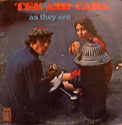Tee & Cara: As They Are (United Artists)
They were more innocent times. People believed in flowers, and peace and love, back then. Most of them disappeared into the real world. Eaten up by it, or absorbed, or disappointed with the brave new dawn, they vanished like the season's blooms, so briefly cherished as emblems of a hope they were soon to lose. Some, though, made an album.
One that encapsulates the time, and yet nobly transcends it, is Tee and Cara's As They Are. A perfect fading Polaroid of the way they were. It makes you want to relive lost days in old sunshine. These teenagers may not have charted, but they wrote songs that are as beguiling as telegrams. They sound so innocently sophisticated, and they even covered a Beatles song. Cara is brown-hair-tied-back wholesome, sixteen, and called Beckenstein. She sports a red mini-dress and on the cover is eating a sandwich while sitting by a fire hydrant beside Tee Saroff. He too is devouring a sandwich, but the click of the camera has made him turn his tartan-capped head in a quizzical, arched-eyebrows manner. At eighteen he sports a vain attempt at facial hair on his top lip and wears a blue pinstriped jacket, probably from a thrift store. They both have Cokes and play guitar, having met at John Adams High School in New York. They look like they're waiting for a lift to Woodstock. Their image is innocent but chic, and the sound is effortlessly cool. Mellow and breezy, they build a subtle bridge between California folksongs and New York's Tin Pan Alley pop.
"A Hard Day's Night" is slowed into a languid, summery song, their harmonies following and entwining in effortless perfection. Their take on "I Got Plenty O' Nuttin'" from Porgy and Bess is one of breezy optimism, while their own ballads are delightful and sincere. "Don't Ask Me Why" and "Keeping Track" are still the perfect early evening serenade for a Manhattan summer, while"Stepping in Time" has a joyous feel that takes them well beyond the city limits. If there were a genre captioned "urban pastoral," Tee and Cara would be major exponents of the form.
There are wistful elements of acid-folk, as well as city-based observations in songs such as "I Don't Think I Know Her" and the delightful "Waiting List." People are still trying to achieve the balance of calculated innocence that these two managed in their teens. Belle and Sebastian have made an entire career from such obsessions, creating much beauty in their wake. What followed for Tee and Cara is presently unknown, but in the summer of 1968 a boy and a girl in New York got something right. All these years on, it remains perfectly and validly so. As they are becomes as they were. That is the only thing to change about this intriguing work of tender charm.

